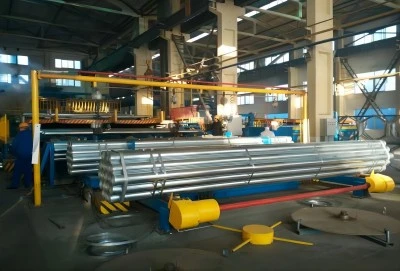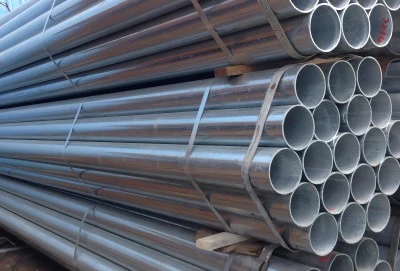Galvanized steel tubing has become an essential component in various industries, from construction to automotive manufacturing. Its unique properties make it a preferred choice for applications requiring durability and corrosion resistance. In this comprehensive guide, we'll explore the nature of galvanized tubing, its manufacturing process, and the advantages it offers in corrosive environments.
|
|
|
What is Galvanized Steel Tubing?
Galvanized steel tubing refers to steel pipes that have been coated with a protective layer of zinc. This zinc coating serves as a barrier against corrosion, significantly extending the lifespan of the steel. The process of galvanization can be applied to various types of steel tubing, including ERW (Electric Resistance Welded) pipes and LSAW (Longitudinal Submerged Arc Welded) pipes.
The concept of galvanization dates back to the 18th century, but it wasn't until the mid-19th century that it gained widespread industrial use. Today, galvanized steel tubing is used in numerous applications, including:
- Water distribution systems
- Scaffolding and construction
- Automotive exhaust systems
- Agricultural equipment
- Outdoor furniture and structures
The versatility of galvanized steel tubing stems from its combination of strength, durability, and corrosion resistance. These properties make it an ideal choice for both indoor and outdoor applications, especially in environments prone to moisture or chemical exposure.
How is Galvanized Steel Tubing Manufactured?
The manufacturing process of galvanized steel tubing involves several steps, from the initial formation of the steel tube to the application of the zinc coating. Let's break down this process:
- Steel Tube Formation: The process begins with the creation of the steel tube. This can be done through various methods, such as ERW or LSAW, depending on the desired specifications of the final product.
- Surface Preparation: Before galvanization, the steel tube must be thoroughly cleaned to remove any dirt, oil, or oxide layers. This is typically done through a combination of mechanical cleaning (such as abrasive blasting) and chemical treatments.
- Flux Application: A flux solution is applied to the steel surface. This helps to remove any remaining oxides and ensures that the molten zinc adheres properly to the steel.
- Galvanization: The actual galvanization process can be carried out through two main methods: hot-dip galvanization or pre-galvanization.
- Cooling and Inspection: After galvanization, the steel tubing is cooled and inspected for quality control. This may include checks for coating thickness, surface finish, and mechanical properties.
The choice between hot-dip galvanization and pre-galvanization depends on various factors, including the intended application of the tubing and the desired thickness of the zinc coating.
What are the Differences Between Hot-Dip Galvanized and Pre-Galvanized Tubing?
While both hot-dip galvanization and pre-galvanization aim to protect steel tubing from corrosion, there are significant differences in their processes and resulting properties:
Hot-Dip Galvanization
Hot-dip galvanization involves immersing the fully formed steel tube in a bath of molten zinc. This process typically results in a thicker zinc coating compared to pre-galvanization. Key characteristics include:
- Thicker zinc coating (usually 45-100 microns)
- Excellent corrosion resistance
- Uniform coating on all surfaces, including inside the tube
- Suitable for harsh environments
- Can be applied to already-formed tubes
Pre-Galvanization
Pre-galvanization, also known as continuous galvanization, involves coating the steel sheet with zinc before it's formed into a tube. Features of pre-galvanized tubing include:
- Thinner zinc coating (usually 7-42 microns)
- Good corrosion resistance for less severe environments
- Smoother surface finish
- More suitable for indoor applications
- Cost-effective for large-scale production
The choice between hot-dip and pre-galvanized tubing depends on factors such as the intended application, environmental conditions, and cost considerations. Hot-dip galvanized tubing is generally preferred for outdoor applications or harsh environments, while pre-galvanized tubing is often sufficient for indoor use or less corrosive conditions.
How Does Galvanization Enhance the Durability of Steel Tubing in Corrosive Environments?
Galvanization significantly enhances the durability of steel tubing, particularly in corrosive environments. This improved durability is achieved through several mechanisms:
1. Barrier Protection
The zinc coating acts as a physical barrier, preventing corrosive substances from coming into direct contact with the steel. This barrier effect is the primary mode of protection in galvanized steel tubing.
2. Sacrificial Protection
Zinc is more electrochemically active than steel. In the presence of moisture, zinc will corrode preferentially, sacrificing itself to protect the underlying steel. This process, known as cathodic protection, continues even if the zinc coating is scratched or damaged.
3. Formation of Protective Patina
When exposed to the atmosphere, the zinc coating reacts with oxygen to form zinc oxide. This further reacts with carbon dioxide to create zinc carbonate, a stable, adherent layer that slows down the corrosion of the zinc coating itself.
4. Self-Healing Properties
In cases of minor damage to the zinc coating, the sacrificial nature of zinc can provide some self-healing properties. Zinc ions can migrate to small damaged areas, providing continued protection.
These protective mechanisms make galvanized steel tubing highly resistant to various corrosive environments, including:
- Coastal areas with high salt content in the air
- Industrial zones with chemical pollutants
- Underground applications with soil-based corrosion
- Environments with frequent moisture exposure
The durability provided by galvanization translates to numerous benefits, including:
- Extended lifespan of steel structures and components
- Reduced maintenance costs over time
- Improved safety and reliability in critical applications
- Environmentally friendly due to reduced need for replacement and resource consumption
It's worth noting that the effectiveness of galvanization in corrosive environments depends on factors such as the thickness of the zinc coating, the specific corrosive agents present, and environmental conditions like temperature and humidity.
If you're seeking reliable and high-performance galvanized steel tubing solutions, contact Longma Group, which provides high-quality galvanized tubing, including A53 galvanized pipe, galvanized mild steel pipe, and ERW galvanized pipe. These products are coated according to internationally recognized standards such as DIN 30670, DIN 30678, CSA Z245.20, EN 10339, ISO 21809-1, AWWA C210, and C213, ensuring reliable performance in various applications. Now, by sending your inquiries to info@longma-group.com. Our dedicated team is ready to assist you and provide tailored product recommendations to meet your specific needs.














